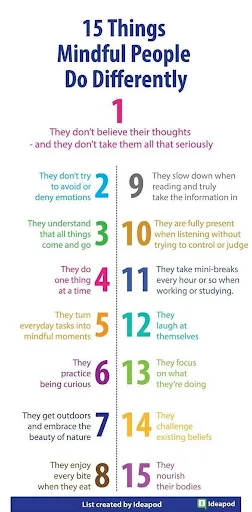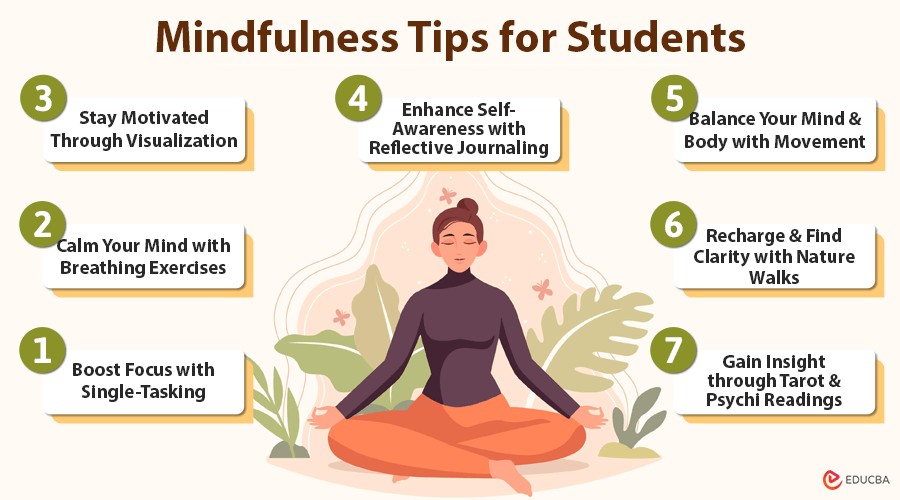Mindfulness in Academia: A Game-Changer for the Modern Student
In today’s fast-paced academic environment, students are constantly pulled in multiple directions—endless assignments, competitive exams, social pressures, and the ever-present distraction of digital screens. Amid this chaos, it’s easy to feel overwhelmed or burnt out. But there’s a growing group of students who are navigating it all with remarkable calm, clarity, and consistency. What’s their secret? Mindfulness.
Far from being a buzzword, mindfulness is the practice of paying attention in the present moment, deliberately and without judgment. For students, it’s not just about meditating under a tree or breathing deeply before an exam—although those help. It’s a mindset that permeates the way they study, interact with peers, handle setbacks, and make choices.
With stress, anxiety, and burnout on the rise in education, mindfulness is no longer optional—it’s essential. Research by organizations like the American Psychological Association and Harvard Medical School shows that mindfulness not only improves focus and emotional regulation but also enhances academic performance and overall well-being.
In this article, we’ll explore the three key things that mindful students do differently—and how these small shifts can lead to big changes in both academic success and personal growth. Whether you’re struggling with motivation or simply looking to enhance your student life, these insights will help you thrive with intention.
Why Mindfulness Matters in Student Life
For today’s students, the academic journey can often feel like a high-stakes obstacle course. Between exam anxiety, packed schedules, social expectations, and digital distractions, maintaining focus and emotional balance is becoming harder than ever. In fact, studies show that student stress and anxiety levels are at an all-time high, with mental health challenges directly affecting performance and overall well-being.
This is where mindfulness becomes not just beneficial—but essential.
Mindfulness is the practice of being fully present and aware of the moment without judgment. It allows students to observe their thoughts and feelings without being overwhelmed by them. Instead of getting stuck in loops of worry or pressure, mindful students learn to regulate their emotions, stay grounded, and return to their goals with clarity.
Numerous scientific studies have validated the benefits of mindfulness in education. According to research published in Frontiers in Psychology, mindfulness enhances attention regulation, working memory, and cognitive flexibility—skills that are critical for academic success. Another study from the Harvard Gazette shows that regular mindfulness practice can even lead to positive structural changes in the brain, particularly in regions associated with emotional regulation and decision-making.
Educational institutions around the world are recognizing its value. Programs like Mindful Schools, The Inner Resilience Program, and CALM (Community Approach to Learning Mindfully) have introduced mindfulness training in classrooms, reporting improvements in student focus, behavior, and stress management.
Moreover, mindfulness empowers students to step out of autopilot mode—that mindless scrolling, cramming, or reacting—and instead make conscious, empowered decisions. According to the American Mindfulness Research Association, students who engage in regular mindfulness practices report better self-awareness, empathy, and resilience—traits that are equally important outside the classroom.
On a more practical level, mindfulness helps reduce test anxiety, procrastination, and perfectionism. Tools like Headspace, Insight Timer, and Smiling Mind offer free or student-focused mindfulness exercises that can be incorporated into study breaks, morning routines, or pre-exam prep.
In a hyper-connected world where attention is currency, mindfulness gives students the ability to pause, breathe, and re-center, making them more effective learners and healthier individuals. And that’s why mindfulness isn’t just a wellness trend—it’s a necessary survival skill for students striving not just to succeed, but to thrive.
The 3 Things Mindful Students Do Differently
Mindfulness is not just a passive state of being—it manifests through small, conscious actions that impact how students think, behave, and learn. Unlike their peers, mindful students don’t just hustle harder; they hustle smarter. They embody habits that make them more emotionally grounded, cognitively present, and creatively focused.
Here are the three things mindful students do differently—and how you can start doing them too.
They Respond, Not React
Picture this: You just got a lower-than-expected grade on an important assignment. For many students, this triggers a knee-jerk reaction—panic, self-criticism, or even defensiveness. But mindful students pause.
Instead of reacting emotionally, they create a space between stimulus and response, a concept rooted in Viktor Frankl’s philosophy. This space allows them to process disappointment, ask themselves reflective questions, and choose a more constructive path forward.
Practices like deep breathing, body scans, and mindful journaling can help develop this response-oriented mindset. Apps like Stop, Breathe & Think and Calm provide short meditations tailored to stressful situations like exams or conflicts.
This ability to respond rather than react has neurological backing. Research from UCLA’s Mindful Awareness Research Center shows that mindfulness increases activity in the prefrontal cortex, the area responsible for thoughtful decision-making, while reducing reactivity in the amygdala, the brain’s stress center.
By learning to observe their emotions without being hijacked by them, mindful students develop emotional intelligence, better interpersonal communication, and greater self-control—skills that contribute not only to academic resilience but lifelong success.

This infographic from Ideapod outlines 15 habits of mindful individuals, highlighting how they manage thoughts, emotions, and daily activities with awareness. It serves as a useful reference for identifying key behaviors that set mindful students apart in their academic and personal lives.
They Focus on the Process, Not Just the Outcome
In traditional academic settings, success is often measured by outcomes—grades, test scores, and accolades. But mindful students flip the script: they focus on learning for mastery, not just performance.
This is known as a growth mindset—the belief that intelligence and ability can develop with effort. Instead of obsessing over results, mindful students bring their attention to the present moment of study: engaging with the material, enjoying curiosity, and noticing when their focus drifts.
Practices like the Pomodoro Technique combined with mindful study breaks improve concentration and productivity. Tools such as Forest App gamify focus by planting virtual trees when you avoid distractions.
Mindful students are also more likely to engage in active recall and spaced repetition—evidence-based strategies that emphasize understanding over rote memorization.
According to a study published in the Journal of Educational Psychology, students who practice mindfulness show higher levels of intrinsic motivation and report deeper learning experiences. This mindset also protects them from academic burnout, a growing concern in competitive environments.
By finding meaning in the process and progress—not just perfection—mindful students build a sustainable approach to both learning and self-worth.
They Create Space for Reflection and Stillness
In a culture that celebrates hustle and hyper-productivity, the act of doing nothing is often undervalued. But mindful students know that silence is not wasted time—it’s essential.
They intentionally make space for stillness—time away from stimulation, social media, and mental clutter. Whether it’s a 10-minute morning meditation, a walk in nature, or simply sitting quietly and reflecting, these moments reset their internal compass.
Research from the American Psychological Association shows that moments of quiet reflection enhance problem-solving, creativity, and emotional processing. This is especially crucial during high-stress academic periods, when decision fatigue is common.
Tools like Insight Timer offer free guided meditations designed for students. Simple habits like gratitude journaling or mindful walking can help students reconnect with themselves and gain clarity amidst chaos.
Reflection isn’t just for mental wellness—it enhances academic strategy, too. By taking time to review what’s working, what isn’t, and how they feel, mindful students adjust their routines proactively, rather than running on autopilot.
They understand what philosopher Blaise Pascal once said: “All of humanity’s problems stem from man’s inability to sit quietly in a room alone.” By embracing stillness, mindful students stay grounded, intentional, and internally motivated—even when the world around them is in overdrive.
How to Cultivate These Habits as a Student
If the mindful student habits you just read about seem inspiring but slightly out of reach, don’t worry—mindfulness is not a personality trait; it’s a practice. The good news? Anyone can start building these habits with small, consistent steps that fit right into a busy student schedule.
The key is starting small and staying intentional.
Build a Daily Mindful Routine (Start with Just 5 Minutes)
You don’t need to meditate for an hour to become more mindful. In fact, studies from Harvard University show that even 8 minutes of daily mindfulness can significantly improve attention, mood, and cognitive performance.
Begin your day with a 5-minute morning meditation to set the tone. Apps like Headspace and Calm offer student-friendly guided sessions that focus on focus, relaxation, and resilience.
Or, try mindful breathing exercises before classes, during breaks, or right before bed. These small moments of stillness train your brain to return to the present moment—even under pressure.
Practice Mindful Studying (Not Just Studying More)
Transform your study sessions into mindful experiences by removing distractions and bringing full attention to your tasks. Use time-blocking techniques like Pomodoro, but combine them with mindfulness.
During breaks, engage in mindful walking or stretching instead of checking your phone. Consider using focus tools like the Forest App, which encourages you to stay present by growing virtual trees when you resist digital distractions.
Create a tech-free study zone and commit to single-tasking—doing one thing at a time with full attention. Research from Stanford University has shown that multitasking reduces productivity and increases stress.
Reflect and Journal Regularly
Mindfulness is incomplete without reflection. Begin or end your day with gratitude journaling or a short entry answering prompts like:
- What did I learn today?
- What emotions did I feel and how did I respond?
- What can I do differently tomorrow?
Tools like Journey or Penzu make journaling digital and private, while traditional pen-and-paper methods remain equally effective.
Reflection also helps track your growth and identify emotional or academic patterns you might otherwise overlook.
Use Mindfulness Tools Tailored for Students
You don’t have to figure it all out alone—there’s an ecosystem of apps and platforms that bring mindfulness into student life:
- Smiling Mind: A free app developed with students and teachers in mind.
- Insight Timer: Offers thousands of guided meditations and music tracks for focus and stress relief.
- UCLA Mindful: Free meditations from UCLA’s Mindfulness Awareness Research Center.
Explore platforms like Mindful Schools if you’re an educator or peer mentor who wants to introduce mindfulness in classrooms or group settings.
Don’t Wait for a Crisis—Start When Things Are “Normal”
Often, students turn to mindfulness only when burnout or anxiety sets in. But the real magic of mindfulness lies in preventative power. As Jon Kabat-Zinn, the father of modern mindfulness, emphasizes: “You can’t stop the waves, but you can learn to surf.”
By embedding these practices during ordinary moments, you build an emotional toolkit that supports you when challenges inevitably arise. Whether it’s a tough exam week, a group conflict, or personal stress, mindfulness becomes your anchor in uncertainty.
Mindfulness is not about being calm 100% of the time. It’s about becoming aware of what’s happening inside and outside of you—so you can choose how to respond. And for students navigating an increasingly chaotic world, that’s a life-changing skill.

This infographic highlights seven practical mindfulness tips tailored for students, emphasizing focus, emotional regulation, and holistic well-being. From single-tasking to nature walks, it showcases simple strategies that mindful students often use to thrive academically and personally.
Small Shifts, Big Impact: Choosing the Mindful Student Path
In a world where academic pressure, information overload, and social distractions are the norm, cultivating mindfulness is no longer a luxury—it’s a necessity for sustainable success. The three habits we explored—responding rather than reacting, focusing on the process over outcomes, and making space for reflection and stillness—are not just helpful tools; they are foundational life skills.
These practices aren’t reserved for monks or wellness gurus. They are real, actionable, and scientifically supported strategies that students around the world are already applying with measurable results. From improving focus and memory to boosting emotional intelligence and reducing anxiety, the benefits of mindfulness are well-documented across leading institutions like Harvard, Oxford Mindfulness Foundation, and APA.
What makes mindful students different isn’t that they’re naturally calmer or more gifted—it’s that they’ve learned to relate to their thoughts, emotions, and challenges in a more conscious way. Instead of being swept away by stress or pressure, they’ve developed a sense of inner clarity, present-moment awareness, and self-regulation that acts like a compass through academic and personal storms.
The beauty of mindfulness lies in its simplicity and accessibility. You don’t need expensive tools, hours of free time, or a retreat in the Himalayas. All it takes is the intention to pause, observe, and be present.
Whether it’s a two-minute breathing practice between classes, mindful journaling at night, or using a focus app during study time, every small step you take rewires your brain for greater resilience and self-awareness.
Mindfulness isn’t about perfect stillness or eliminating stress. It’s about being able to meet your experience—whatever it is—with clarity, presence, and compassion. And in doing so, you don’t just become a better student; you become a more grounded, intentional version of yourself.
So start today. Breathe. Observe. Reflect. The results may surprise you—not just in your marks, but in your mindset.
Frequently Asked Questions On The 3 Things Mindful Students Do Differently
What is mindfulness in the context of student life?
Mindfulness for students means paying full attention to the present moment—whether studying, listening in class, or managing stress—without judgment or distraction.
How does mindfulness help improve academic performance?
Mindfulness enhances concentration, reduces anxiety, and improves memory retention, all of which contribute to better academic outcomes.
Can mindfulness help with exam stress?
Yes, mindfulness reduces cortisol levels and promotes emotional regulation, making it easier to manage pre-exam nerves and stay calm during tests.
Do I need to meditate every day to be mindful?
Not necessarily. While daily meditation is helpful, mindful moments can be as simple as deep breathing before a class or paying full attention while reading.
What’s the difference between mindfulness and relaxation?
Relaxation is a goal-oriented state of calm, while mindfulness is about observing whatever you’re experiencing—calm or not—with awareness and acceptance.
Is mindfulness backed by science?
Yes. Research from Harvard, UCLA, and other institutions shows mindfulness improves brain function, mental health, and cognitive flexibility.
Can mindfulness help students with ADHD or anxiety?
Absolutely. Mindfulness practices have been shown to improve focus and reduce anxiety in students with ADHD and other attention-related challenges.
What’s the easiest way to start practicing mindfulness as a student?
Begin with a 3–5 minute breathing exercise daily or try a guided meditation using apps like Headspace or Smiling Mind.
How can I be mindful while studying?
Use single-tasking, silence your phone, and take mindful breaks to reflect or walk instead of multitasking or doomscrolling.
Is journaling a form of mindfulness?
Yes. Journaling helps you reflect on your thoughts and emotions, making it a great tool for self-awareness and mental clarity.
What are some mindfulness techniques that don’t require sitting still?
Mindful walking, slow stretching, or even brushing your teeth mindfully can help bring awareness to the moment.
How long does it take to notice the benefits of mindfulness?
Some students notice changes in a few days, but consistent practice over 4–8 weeks shows measurable improvements in focus and emotional regulation.
Can mindfulness help with time management?
Yes. Being mindful improves awareness of how you spend your time and helps you make intentional choices rather than reacting impulsively.
What’s a good mindfulness habit to include in a daily routine?
Start or end your day with 5 minutes of stillness, gratitude journaling, or breathing practice.
Is mindfulness a religious or spiritual practice?
Mindfulness has roots in Buddhist traditions, but in modern settings it is taught as a secular, science-based mental skill.
Can group mindfulness sessions help students?
Yes. Practicing with others can build accountability, foster connection, and normalize conversations around mental well-being.
How do I avoid overthinking during mindfulness exercises?
Overthinking is normal. When thoughts arise, gently bring your focus back to your breath or body sensations without judging yourself.
What if I feel like I’m failing at mindfulness?
That’s part of the process. Mindfulness isn’t about being perfect—it’s about noticing when your mind wanders and returning to the present.
Can mindfulness improve sleep quality for students?
Yes. Practices like body scans and mindful breathing before bed can reduce mental chatter and promote deeper sleep.
Is mindfulness useful outside of academics?
Absolutely. It helps with relationships, emotional resilience, decision-making, and navigating daily stress far beyond the classroom.
-Authored By Pragna Chakraborty





